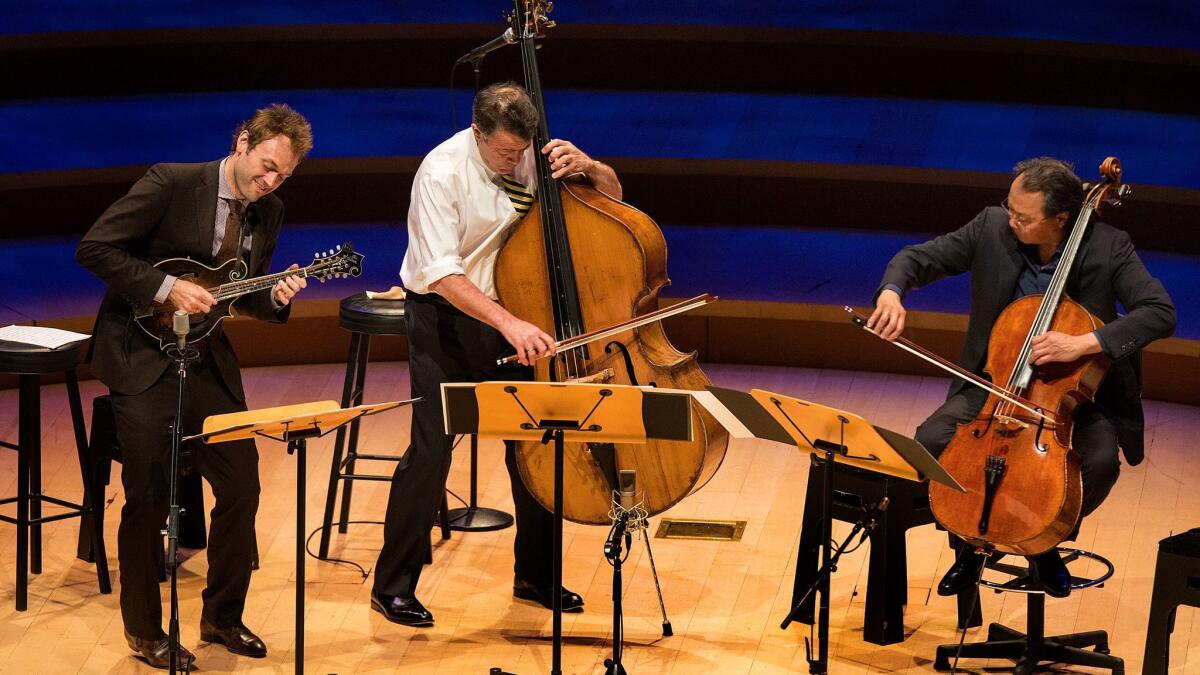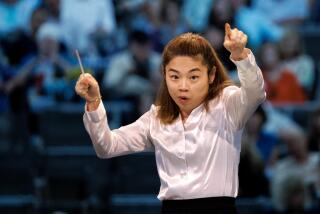Critic’s Notebook: Instrumental mayhem in the name of Bach: Yo-Yo Ma, Chris Thile and company

What would Johann Sebastian Bach make of a goat rodeo?
There can be little doubt that the greatest composer ever would have been unfazed hearing his music played by a trio of cello, mandolin and bass, as Yo-Yo Ma, Chris Thile and Edgar Meyer did at Walt Disney Concert Hall on Wednesday night. Five years ago the three took part in what became known as “The Goat Rodeo Sessions,” unlikely musicians on unlikely instruments in concerts and on bestselling recordings that were part blues, part bluegrass and a smidgen of Bach. Although sometimes slang for hapless chaos, for everything that can go wrong going wrong, a goat rodeo can also imply that out of pandemonium can come something new.
Bach knew the mandolin, cello and bass in their earlier incarnations. He never wrote for such a trio, but had virtuosos like these been among his beer-drinking buddies in Leipzig, he undoubtedly would have come up with some entertainment for them.
The one thing Bach might have wondered about, though, is why the Ma-Thile-Meyer trio was so respectful. Composers in Bach’s Baroque day thought nothing of adapting their music and other people’s music for different instruments. They did so by freely rewriting, as much if not more so than what is common in what pop music calls covers.
So how about Gloria Cheng playing a Brahms piano transcription of Bach’s D-minor Chaconne for violin on a harpsichord, as she did to end her Tuesdays@Monk Space recital the day before? Brahms’ keyboard style, a century after the Baroque, would surely have intrigued Bach, as would the new-fangled piano. Brahms’ transcription is for left hand alone to take advantage of the resonances of the lower notes on the piano, a sound that would have been arresting to Bach’s ear.
The one thing, here, to mystify Bach was the harpsichord itself. Cheng’s copy of a 1729 double manual harpsichord would be familiar enough. But why use it for a piano piece?
In Bach’s time and up until the early 20th century, composers jumped on the latest technological bandwagons, whatever that might be. Invent a clarinet and Mozart won’t be able to get enough of it. Once the piano had become the keyboard of choice in the 19th century, the fashion became to turn old harpsichords into furniture.
That interest in new instruments or the radical evolution of older ones suddenly stopped in the early 20th century. Orchestras became fossilized, with modern instruments — be they saxophones or synthesizers — as occasional add-ons, not part of the permanent ensemble. Changes in standard instruments were restricted to minor refinements.
Invention didn’t cease, but in the 1950s new instruments, and particularly electronic ones, were the purview of the avant-garde and of commercial music. At the same time, an early music movement was born with the intent of returning old music to old instruments and playing them as historians imagined they had once been played, something known as historically informed practice, or HIP.
What we now have, with the likes of musical goat wranglers at Disney and with Cheng’s harpsichord recital mixing old and new music, is a kind of HIP replacement.
With HIP replacement, Cheng’s harpsichord could now offer an evening of novelty. She began with Lou Harrison’s Six Sonatas for Cembalo, written in 1943, which use the harpsichord like a modern West Coast percussion instrument, but which also allude to Baroque practices, particularly in tuning. In honor of the centenary of Harrison’s birth on May 14, Cheng chose one of his favorite old tunings, the Werkmeister III temperament, which is close to the equal temperament that Bach eventually adapted, but not quite the same, giving some intervals an exotic microtonal tinge.
A Bach violin chaconne felt, not surprisingly, fresh. Brahms’ piano transcription was returned to a Bachian harpsichord but tuned a little differently, so that it sounds closer to a Baroque violin yet also with a very distant flavor of Lou Harrison’s California. Cheng played not with the left hand but both hands to better control harpsichord resonance felt.
It also helped that Bach came after various examples of early and new harpsichord music. This included exploring a 1650 suite by Louis Couperin, in which the musician has the fancy of supplying rhythm, and Sally Mosher’s 2003 “Out of the Silence” that played off the same principal suitability for modern music.
Many modern composers note the return to the harpsichord, especially when a pianist like Cheng, who is well known for premiering much new music, takes an interest in the early instrument. Elsewhere on her program were recent pieces by Veronika Krausas, Carolyn Yarnell and Karen Tanaka, each exploring hidden resonance resources in the instrument, as well as György Ligeti’s 1978 flamboyantly Minimalist “Hungarian Rock.”
Am I being presumptuous to think that that response of Bach — sitting on a folding chair in Koreatown’s Monk Space and perhaps slightly piqued that wine rather than beer was served — to dazzling recital could have been: “I wish I’d thought of that”?
I’m not so sure Bach would have had the same thought about the Ma-Thile-Meyer trio, for the simple reason that he already had thought of most of what they did. They found ways to make the combination of instruments work, the bass often plucking harmonies, the cello playing singing lines and the mandolin a harpsichord stand-in, all the while honoring every gesture Bach asked for.
They played a program similar to that on their new Bach trio recording, beginning with a straightforward transcription of an organ trio and ending with a straightforward transcription of a viola da gamba sonata that Ma once recorded on the cello with harpsichord accompaniment. They went, more often than not, for refined lyricism, and when melody reigned, all three became absorbed in conveying exquisite beauty. They found clever but still dutiful solutions for handling fugues from “The Well Tempered Clavier” and “The Art of the Fugue.”
But when they played a rocking “Goat Rodeo Sessions” encore, “Quarter Chicken Dark,” they cut loose. My second presumptuous guess is that’s what would have excited Bach, as it did everyone else in the sold-out hall. HIP replacement, yes, but not simply for the sake of restoration hardware.
ALSO
Gustavo Dudamel has tried to stay out of politics. Now, he’s demanding action in Venezuela
Diary of a world premiere: Join playwright Rajiv Joseph as the curtain rises on his ‘Archduke’
CAP UCLA teams up with Theatre at Ace Hotel: Why shows are moving from the Westside to downtown
More to Read
The biggest entertainment stories
Get our big stories about Hollywood, film, television, music, arts, culture and more right in your inbox as soon as they publish.
You may occasionally receive promotional content from the Los Angeles Times.











